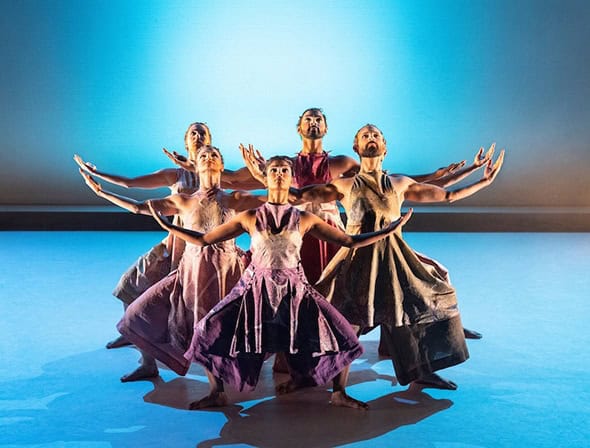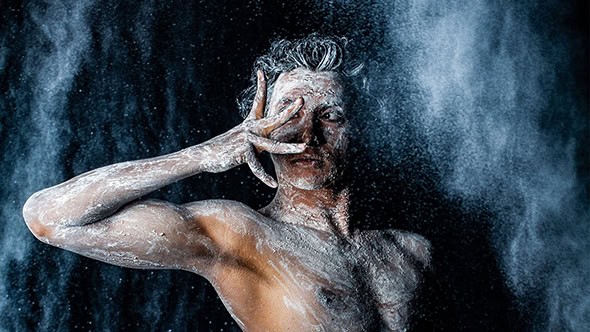Ian Abbott on Seeta Patel’s re-imagining of The Rite of Spring at The Place
Posted: May 29th, 2019 | Author: Ian Abbott | Filed under: Performance | Tags: Ash Mukhurjee, Celine Lepicard, Indu Panday, Kamala Devam, Moritz Zavan, Sarah Gasser, Seeta Patel, Sooraj Subramaniam | Comments Off on Ian Abbott on Seeta Patel’s re-imagining of The Rite of Spring at The PlaceThe Rite of Spring – reimagined by Seeta Patel, The Place, May 18

Last Summer at Tanzmesse I saw an eight-minute excerpt of Seeta Patel’s reimagining of The Rite of Spring; nine months later I’m here at The Place to see how it has grown. Patel is presenting the completed work with six dancers alongside two shorter and complimentary works that establish the relationship between western classical music and group bharatantyam choreography. Celine Lepicard ably performs Bach’s cello suite 1 and a seven-minute group bharatanatyam and contemporary dance choreographed by Patel on alumna from the National Youth Dance Company and Kadam Dance readies the eye and ear palette for what is to come.
There have been over 200 choreographic attempts at matching Stravinsky’s score since it premiered in 1913; it’s a choreographic equivalent of scaling Everest or circumnavigating the globe — there’s a psychology in a certain type of person to see if they’re able to endure, match and conquer it whilst marking their own place in dance history. (Having only seen Marie Chouinard’s version at the Attakkaalari India Biennial in 2017 I do not have Rite fatigue).
At the moment there’s at least two other versions circulating in the UK: Jeanguy Saintus’s interpretation for Phoenix Dance Theatre and Yang Liping’s version but Patel’s is the first time in 106 years that bharatanatyam has been used. As a side note, when I listen to Rite I cannot avoid thinking about how the musical thief John Williams appropriated a number of the key Stravinsky/Rite passages, so even you’ve not heard Stravinsky’s version in full, you’re likely to have heard Williams’ lift in Star Wars (The Dune Sea of Tatooine).
With Ash Mukhurjee, Indu Panday, Kamala Devam, Moritz Zavan, Sarah Gasser and Sooraj Subramaniam as the dancers, Patel has brought together the Avengers of classical and contemporary bharatanatyam; this suite of highly skilled performers deals with and executes the choreographic complexity demanded of them with a finesse and grace that makes visual music. The score envelops the auditorium and although it is played too loud, distorting slightly, you feel it surrounding you; the music is in you as you attempt to take in all the visual information. The dancers are pin sharp, have been rehearsed exceptionally and deliver thunderous synchronised foot work; it’s one body echoed across six as they duet with the weight of history and the music. One of the most impressive aspects is how the dancers travel; they gobble up the width of the stage with ease; if you were to trace the dancers on a Strava map they’d have covered miles by the end of the work.
The visual composition, anatomical layering and choreographic cannon is satisfying and demonstrates for the first time that bharatanatyam can be a group dance form; imagine a miniature corps de bharatanatyam. If the dancers are the Avengers then Patel is Nick Fury — the architect of this work bringing together the finest dancers from across Europe but with Patel’s ambition and skill they level up again, combining to deliver a work that marks a shift in the UK bharatanatyam ecology. This Rite of Spring is begging for a bigger stage, with double/treble the dancers and live orchestral accompaniment and could easily tour internationally for the next five years.
Devam, Subramaniam and Mukhurjee leave the eyes tired after darting in between where we spend our attention. Patel’s composition delivers wave after wave, and it’s a relentless first half that is unforgiving in its attack. The second half wanes a little in impact as The Sacrifice demands an alternate energy and concentration but it is still a joy to watch and a welcome addition to the choreographic canon. Cyril W. Beaumont — a British book dealer, balletomane, and dance historian — saw each and every one of Nijinsky’s performances in the Ballet Russes’ 1913 London season (which included Nijinsky’s original Rite of Spring) and said: “The chief attraction for the season was to be Nijinsky, presented as a strange, exotic being who could dance like a god. His slanting eyes and his finely-chiselled lips were to be emphasized with grease-paint; his roles were to be of the most unusual type.”
There is a relationship that warrants further exploration around new classicism and the exoticisation of how Nijinsky was written about and presented, what Patel has done with her re-imagining and how it has been written about in terms of ‘otherness’.
Dance is always presented in a context and Patel’s context needs wider acknowledgement. She is performing and touring in Not Today’s Yesterday, a contemporary solo work co-authored and choreographed with Lina Limosani; she developed in partnership with Gandini Juggling an award-winning work Sigma in which she’s a central pillar; she has co-developed The Natya Project with Shane Shambhu and Magdelene Gorringe — a training programme for younger bharatanatyam dancers in response to the lack of dancers in the profession — and she is still creating/touring her own classical evening of works. If she were male with a name like Khan, McGregor or Shechter she’d have her own choreographic centre, be heralded as a UK pioneer with regular funding to match.
